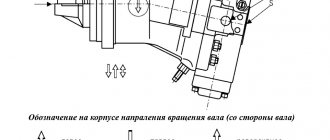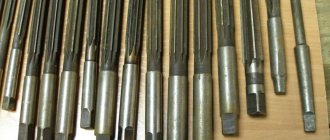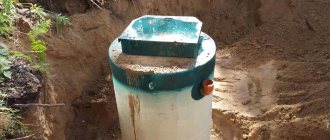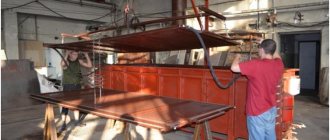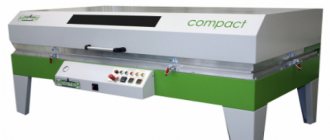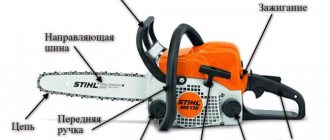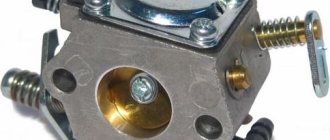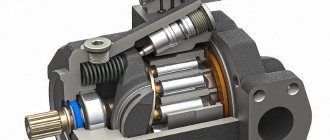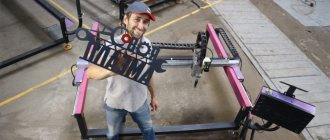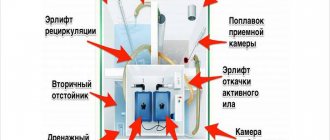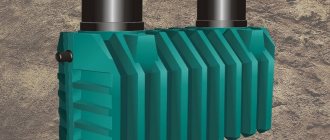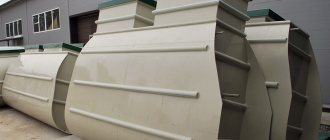Is ventilation really necessary?
Important!
When performing cleaning or grinding work using a sandblasting machine, installing a minimum ventilation system is required.
During operation of a shot blasting machine using sand, a large amount of dust is generated. It consists of small particles that have broken off both from the surface being cleaned (rust, old paint, particles of the top layer of the surface of the product), and due to the breaking of the abrasive material itself during impact.
Quickly filling the room, dust settles on equipment and is inhaled by personnel. In addition, due to low visibility, the quality and speed of work is reduced. Lack of ventilation in the sandblasting chamber is also dangerous for the equipment. The resulting dust settles on the floor and mixes with the used abrasive material. This overloads the machine and causes it to wear out quickly.
We make a sandblasting chamber with our own hands: drawings, components, assembly
A sandblasting chamber is a useful device that allows you to effectively and with the maximum degree of safety, using abrasive material, clean various surfaces from contamination, remove traces of corrosion and old coatings.
Ejector-type sandblasting chamber
Not only ordinary quartz sand, but also a number of other materials can be used as an abrasive powder, which is sprayed in such a chamber under high pressure:
- shot made of steel or cast iron;
- glass granules;
- electrocorundum;
- slag materials obtained after the production of copper and nickel (cooper slag and nickel slag).
Sand of various fractions
The choice of one or another abrasive material depends not only on the type of surface being treated, but also on what needs to be cleaned from it.
Factory-made sandblasting chambers: as we can see, there is nothing overly complicated in their design
Principle of operation
Sandblasting chambers, which are called inhabited if the processing process is controlled by a specialist located outside them, many home craftsmen prefer to do with their own hands, as it is simple and profitable. The advantages of this approach also lie in the fact that self-manufacturing of such a chamber allows you to give it the dimensions and configuration that are optimally suited for processing products of a certain type. In this matter, the master who makes the sandblasting chamber has practically no restrictions: it can be either a small box for processing miniature products, or a whole hangar in which large-sized metal structures will be placed.
Operating principle of the sandblasting chamber
Even taking into account the fact that both industrial and self-assembled sandblasting chambers are safe, when working with them you should use protective equipment, which traditionally includes:
- respirator;
- work glasses;
- special closed clothing and shoes.
Processing the part in a sandblasting chamber
Sandblasting chambers, if manufactured correctly, in addition to versatility, provide the following advantages to the specialist working with them.
- Using such chambers, it is possible to sandblast products of almost any size and configuration.
- The entire processing process, performed using a special nozzle, can be monitored visually, which is ensured by a special viewing window.
Large viewing window provides good visibility
Recommendations for making a sandblasting chamber
Before you start making a sandblasting chamber with your own hands, you need to decide on its dimensions and draw up a simple drawing, which will allow you to correctly select and prepare all the necessary materials. The dimensions of the chamber depend not only on the size of the products that you plan to process in it, but also on the area of the space intended for its installation.
Main dimensions of the chamber for processing small parts
Particles of sand, as well as any other abrasive material, moving in the chamber at high speed, will ricochet off its walls, which does not have a very good effect on the quality of the processing performed. That is why it is undesirable to make the internal size of such a device too large (or, if you need a large chamber, you can line its internal walls with soft material, such as technical rubber plates).
A sandblasting chamber used at home is, in fact, an ordinary box, the inner walls of which are lined with metal sheets. Such a camera, if its dimensions allow, can be placed in any utility room or even in the garage, making it stationary or mobile.
A version of a homemade sandblasting chamber with a convenient retractable tray. The photo below shows the stages of manufacturing and assembly
Algorithm and assembly rules
A sandblasting chamber - both industrial and self-assembled for home use - must be equipped with a ventilation system that will ensure the removal of dust generated in large quantities during processing. As mentioned above, when working with such a camera, no matter how well it is made, it is necessary to use eye, respiratory and entire body protection.
The structural elements that you will need to make a sandblasting machine used in conjunction with such a camera are:
- a container for abrasive material from which it will be supplied to the processing zone;
- a compressor that provides the necessary pressure of the air flow mixed in the system with abrasive;
- a nozzle through the internal hole of which the abrasive mixture will be supplied to the processing zone;
- gun for controlling the nozzle and making it easier to work with;
- a ball-type valve that will allow you to adjust the flow parameters of the abrasive mixture;
- elements that ensure fastening of all structural parts and their sealing.
Interior of the chamber with the side door open
To make the sandblasting chamber stable, you can place it on a work table or make a special stand for it from a metal profile. For the inner walls of the sandblasting chamber, it is better to use sheet metal whose thickness does not exceed 1 mm.
In order to be able to constantly monitor the sandblasting process and effectively manage it, it is necessary to make an observation window on one side of such a chamber, and organize a lighting system in its inner part. It is better to use impact-resistant plastic as the material for making such a window (ordinary glass may not withstand significant loads and quickly fail).
To control the sandblasting nozzle, which will be located inside the chamber, two symmetrically located holes must be made in the front of the latter. The diameter of such holes in which work gloves will be fixed should be approximately 100 mm. It is necessary to take into account the fact that the work gloves located inside the chamber will quickly become unusable, so it is necessary to ensure that they can be quickly and easily replaced with new ones.
Transition cuffs - an easy way to quickly change work gloves
A chute should be placed under the bottom of the sandblasting chamber, with the help of which the waste material will be collected in a special container, so it is best to use durable mesh material to make the bottom. The collection of waste abrasive material, if done carefully, will allow it to be reused, which will significantly reduce the cost of processing. To effectively illuminate the interior of the sandblasting chamber, it is best to use two lighting fixtures located at two different edges of its upper part.
Abrasive material collection hopper (bottom view)
The sandblasting nozzle, with which the treatment is carried out inside the chamber, is located in its internal part, and its connection to the container with sand and the compressor is ensured using special hoses. You can hang a large door on the back wall of a homemade sandblasting chamber (you can also cover the wall with a tarpaulin), which will allow you to easily place products of various sizes and configurations into it.
When starting to assemble a sandblasting chamber with your own hands, you should take into account that only high-quality structural elements, as well as strict adherence to the recommendations of experienced specialists and a previously developed drawing, can ensure the durability and high efficiency of using such a design.
met-all.org
Principle of operation
There are two ways to filter the air in the sandblasting chamber:
- A fan is a simple and cheap way to organize a hood. Its performance must be calculated in such a way that the total volume of air in the chamber changes in no more than 2 minutes. But this method has quite a few disadvantages: dirty air will escape into the street, an additional cleaning filter will be required, and under heavy loads the fan quickly breaks down.
- A cyclone with a self-cleaning filter system is an expensive but effective way to clean an uninhabited sandblasting chamber. The design consists of a powerful dust-proof fan and cartridge filters equipped with a shaking system. The principle of operation is to suck air from the chamber and supply it to the filters. At the exit, it is cleaned of dust and small abrasive particles. The equipment is connected to the power supply network.
The cost of installing ventilation with self-cleaning filters is 15–20 times more expensive than a fan, but it can eliminate problems with environmentalists for a long time and provide comfortable working conditions.
Sandblasting ejection chamber with cyclone. — DRIVE2
Hello!
Having a compressor (not a small one) in the garage, I want to surround it with equipment and tools powered by compressed air. The ultimate dream of mine is a sandblasting chamber. It turned out to be very simple, 10 working days and 3000 rubles)))
A corner littered with rubbish was replaced by a sandblasting chamber.
At work, a discarded metal cabinet was waiting in the wings.
Marked and cut off the excess.
Door. Bent the panels.
All connections are made with aluminum rivets.
The 100X100 mesh was welded in half, making it 50X50 and stronger. Sleeve rings.
Snail from a Soviet window air conditioner. Galvanized cone.
The motor is from a Siberia 6 washing machine. The shaft is machined under the impeller.
The barometer box was perfect for storage.
Made the transition to ventilation. Removal from the camera.
How empty it was and how beautiful it became) I connected a two-position toggle switch for 15A. When the light in the chamber with the cyclone motor is turned on (parallel connection), the lamps in the room are turned off so that the light from them does not interfere with looking into the camera. I made an extension cord from a nylon tube onto the toggle switch to make it easier to turn off the camera in the dark.
Connected the compressed air supply hose. Regulator and dryer with filter. The door on one small latch closes tightly.
At the bottom I thought of making a stainless glass (there was a blank) with a removable bottom so that the sand could be easily poured out. The ejection tube is fixed.
The sandblasting gun can be easily removed from the chamber; you can go outside with it, insert it into a bucket of sand and clean the car body, for example.
Along the contour I put on some kind of plastic tube cut lengthwise (on one side) so that the sleeves would not rub against the sharp edge. The gloves are split leather, and I cut my brother’s ski pants into the sleeves)))
The cyclone turned out to be very powerful, so that the flow would not go into the compressor room (down the ventilation) I made and installed a throttle.
Regular construction sand. He calcined it on the stove, sifted it and poured one bucket into the chamber.
For dessert - a video.
PS I'm happy! Now I can throw away the sandpaper and brushes)))
www.drive2.ru
What filters are used in ventilation?
To purify the air, filters made of special materials (polyester, cellulose, cellulose-polyester) are used. The main task of such cartridges is to trap dust on their walls. Filters are chosen depending on the materials they work with.
For regular cleaning of air and cartridges, a special automatic filter cleaning system is used. The use of such ventilation significantly extends the life of the entire installation.
Important!
The self-cleaning system uses a pulse of compressed air to shake the filter and knock off adhering dust and dirt. Accordingly, this type of cleaning system requires a source of compressed air to operate.
Buy or make a homemade sandblasting chamber?
For a habitable sandblasting booth, the answer is no: there is too much to consider during the design and manufacturing process of the installation. Moreover, the profile sector of the market is replete with various offers adapted to the desired performance and final energy costs. For example, the price of an inhabited pressure-type sandblasting chamber, agreed with the individual requirements of the customer, starts from 1.8...2.0 million rubles.
The set of such equipment includes:
- Housing (it can be made of profiled steel or sandwich panels).
- A gateway equipped with swinging double-leaf gates (in walk-through type cells there is a similar unit on the opposite side).
- A grating flooring, at the bottom of which there are waste sand collection systems based on pneumatic suction.
- A ventilation system designed for a specific air exchange.
- Control and lighting systems for the work area.
- One or more abrasive blast cleaning stations.
- Protective equipment for workers.
DIY hood
To make a hood with your own hands, you will need:
- electric motor with a power of 0.3-0.75 kW;
- volute for air removal or propeller with blades;
- filter.
The sandblasting chamber is equipped with a compressed air supply hose, volute or blades connected to the engine. The snail’s “nose” is mounted inside the chamber and sealed tightly. The blades, using an electric motor, will create the necessary vacuum to suck in polluted air.
A cleaning filter made of polyester, cellulose or a combination is installed at the outlet. With proper installation and complete sealing of the structure, correct operation and durability of the system can be guaranteed.
The chamber of the sandblasting machine must have a ventilation system. For small volumes, you can use a homemade fan-based hood. For production scales, a ventilation system with self-cleaning filters is ideal.
Sandblasting chamber - from purchase to DIY production
If there is a need to clean various products from old paint and rust and, in connection with this, there is a desire to make a sandblasting chamber for your home workshop with your own hands, then first of all you need to understand the peculiarities of the operation of such equipment. After all, abrasive blasting has several fundamentally different varieties, and the equipment used in this technology has a wide range of characteristics and sizes: from hand guns that work with large objects in the open air, to sealed chambers the size of a desk, which can be placed in a garage or country house. .
This surface cleaning method is suitable for removing sagging, drips and other irregularities from concrete. Sandblasting machines are used to remove old paint from car body parts and wheel rims, and also impart the necessary roughness to the metal before painting and applying polymer coatings. Another area of their application is matting glass and polished surfaces, including using shaped patterns to create various patterns and designs. When sandblasting, various types of abrasive powders are used, and quartz sand, which gave the name to this technology, has long been prohibited in industrial production due to non-compliance with modern sanitary and hygienic standards.
Types of sandblasting chambers
There are two types of sandblasting chambers: inhabited and uninhabited. In the first case, these are large sealed rooms in which the operator manually processes the workpiece (see figure below). The walls in them are covered with a soft shock-absorbing material that dampens the ricochet of abrasive particles.
The part is treated with an air-abrasive mixture, which, together with the blasting material, falls onto the grated floor of the sandblasting chamber. Through it, abrasive, dust and particles of cut material enter the collection and return device, which feeds this mixture into a cyclone separator, where it is separated into abrasive particles and dusty waste (destroyed elements of the working mixture and material removed from the surface). The former are fed down into a hopper for reuse, and the latter into a dust collector located outside the sandblasting chamber.
Uninhabited sandblasting chambers are, as a rule, small rectangular cabinets in which the operator, putting his hands through a hole in the front wall, processes the part without coming into contact with the air-abrasive medium.
They are designed for processing small products, and it is this type of sandblasting chamber that is usually made by craftsmen. In such installations there is no cyclone-separator, the hopper for accumulating the waste mixture is located directly under the grated floor of the chamber, and dust is removed using an exhaust hood, which, given its small volume, works quite efficiently.
Another type of sandblasting is cleaning surfaces outdoors. In this case, the abrasive material is consumable, since it is dispersed over the entire area in the work area and it is almost impossible to ensure its recirculation. A type of habitable processing is work in closed vessels and large-diameter pipes.
Design and principle of operation of the sandblasting chamber
In small industries and home workshops, as a rule, they use only uninhabited sandblasting chambers or work with a gun in the open air. An inhabited chamber is a complex and expensive industrial product, so only the first two types of processing will be considered further.
All habitable chambers have almost the same design and differ only in their equipment, as well as the quality of components and components. Such a chamber is a metal cabinet with a beveled lid, into which an observation window is mounted (see figure below).
In the front wall of the cabinet there are two round holes with sealed cuffs into which the operator inserts his hands while working. The floor of this sandblasting chamber is grated. Through it, the spent abrasive is poured into the lower part, made in the form of an inverted truncated pyramid and serving as a storage container. Dust is removed using an extractor through a filter into a special dust collector. The product is loaded in such devices through a door located on the rear or side surface of the cabinet.
According to the type of supply of the abrasive-air mixture, sandblasting machines are divided into two types: injection machines, in which air and abrasive are supplied to the sandblasting gun through separate hoses, and pressure machines, in which air and working powder are mixed in advance and sent to the nozzle through one channel. In uninhabited devices, the first type is usually used, which is due to the peculiarity of their design. For the same reason, cyclones are not used in such sandblasting chambers, since the separation of dust and working powder occurs directly in the working area.
Mobile pressure units are mainly used for outdoor work. Such a device includes three main components: a compressor, a container with abrasive material and a sandblasting gun (see figure below).
The compressed air in such a device is divided into two streams. One of them goes directly, and the second creates pressure in the container, squeezing the working powder out of it into the dispenser. Next, the abrasive is mixed with the first air stream and enters the nozzle of the sandblasting gun.
In the video below you can watch the process of manufacturing a pressure sandblasting unit, which the author turned out to be no worse than the factory one.
What to look for when buying a camera
When choosing and developing your own sandblasting chamber, first of all, you need to check the compliance of the diameters and lengths of its hoses with the performance of the compressor. Other important factors to consider:
- Air Dryer. Moisture in the air-abrasive flow makes it uneven, because in this case the powder particles stick together into large fractions of different sizes.
- Reservoir capacity for working powder. In open systems, an operating time of at least 30–40 minutes must be ensured.
- Tank slope. It should be no more than 40º, otherwise the powder will not pour well into the dispenser.
- Calibrated sieve on the loading funnel. Helps remove various impurities and large particles. Particularly useful when reloading abrasive after use.
- Protective mesh in front of the camera viewing glass. With good lighting it does not interfere with work at all, while protecting the glass from rapid frosting.
- Ease of loading. The door must provide access to the entire interior of the cabinet.
- The presence of a sufficiently powerful hood and a large dust container.
The nozzles of pressure sandblasting machines provide greater productivity and ease of use, due to the fact that the air-abrasive mixture is supplied to them through one hose. However, such devices require compressors with high air flow rates.
How to make a camera with your own hands
Making a sandblasting chamber is not difficult, because by its design it is perhaps the simplest of all home-made devices for home workshops. On the Internet (especially foreign) you can find drawings of such installations, which are in no way inferior to factory ones (see figure below), but most craftsmen make them according to their own sketches, based on their own preferences, as well as the availability of suitable materials and components.
Basic Installation Elements
Homemade sandblasting chambers practically repeat the factory ones in their design, since it is probably impossible to somehow improve or even simply change this simple and streamlined process.
The main components of such an installation:
- support structure for camera installation;
- a housing with an inspection window, a loading door and a prismatic hopper into which waste abrasive is poured;
- window glass;
- cell floor mesh;
- hood;
- compressor;
- working pistol;
- fittings, valves and hoses.
The body of the sandblasting chamber is usually made of rolled sheets, although many households use chipboard or plywood for this, and also combine wood and metal structures.
Construction of the work area
The size of the working area for all uninhabited type sandblasting chambers is approximately the same, since it is determined by the ergonomics of the operator’s work. The depth of the cabinet should provide access to the part from any side, i.e. be within arm's length with a sandblasting gun. And the height is limited by the level of the viewing window, which should be opposite the operator’s face. The part is loaded into the processing zone through lockable doors located on the side or rear surface of the chamber.
Making the bottom
Structurally, the bottom of the chamber is perhaps the most complex element of the entire installation. In its form, it is a traditional prismatic hopper for bulk materials, in the lower part of which there is an outlet valve. To correctly cut sheet metal and weld such a structure, certain skills are required, so many people use an angle frame onto which sidewalls made of various sheet materials are attached in different ways.
Hood design
According to sanitary standards, a hood is a mandatory component of any sandblasting chamber. In addition, it removes dust and provides acceptable visibility in the treatment area. The hood must provide high performance, and the motors must be dust-proof. Making such a device from available components of used household appliances is not easy. This is probably why many home craftsmen use homemade sandblasting chambers without hoods. In the video below you can see a successful example of such a device with two impellers.
In articles and videos, authors of homemade sandblasters pay practically no attention to the consumption of purchased abrasive materials, since most often they use ordinary quartz sand. How much does it cost to completely fill a sandblasting chamber with, for example, cooper slag or nickel slag? And how many full cycles do such powders retain their functionality? If you know anything about this, please share the information in the comments.
wikimetall.ru
Communities › DIY › Blog › Sandblasting chamber. Part 2.
After yesterday's post I received a lot of valuable advice on camera design, thank you all! Part 2 was already ready, but yesterday I couldn’t post it, so I ask you to refrain from strong criticism of the ventilation system
I myself already understand that there is no point in filtering the air in the chamber.
After yesterday's comments, I realized that it is easier to vent it outside
. I want to cover the inside walls of the chamber with rubber (also based on numerous recommendations), there is no metal in the garage anymore, and there are a lot of old car mats.
I’m making a camera for the first time and have never sandblasted before, I’m also limited in materials and resources, I mostly make it from what’s lying around in the corners.
I'll just comment on the photo.
Comments 89
Thanks, I'll take note for the future!
